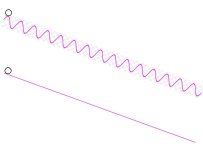Hummina Shadeeba
1 MW
goatman said:if you go to ebikes.ca, all axle motor page it shows cogging effect with different magnets
https://ebikes.ca/product-info/grin-products/all-axle-hub-motor.html
if you go to phaserunner page theres a field weakening link that brings you here
https://endless-sphere.com/forums/viewtopic.php?p=984725#p984725
which makes me think that field weakening is like a delta/wye switch, inject enough amps and double your speed.
im going to have to go read up on this to see if that is actually what foc is, a delta/wye switch
makes sense greater cogging with stronger magnets, and the cogging torque looks linearly produced related to rpm/frequency, as apposed to exponential with eddies.
i dont know how field weakening is done through programing but i dont think it would relate to cogging. cogging seems entirely dependent on the motor design. cogging is a fundamental, simple, "hardware" issue. it needs an explanation based on the basic laws of physics as apposed to more complex programing stuff. so i believe
but what causes cogging? does it produce heat? it makes more sense it being a form of hysteresis being linear. any leads?


